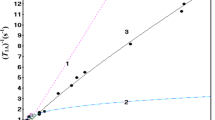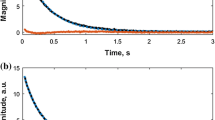Abstract
Different nuclear magnetic resonance (NMR) methods such as spectroscopy, diffusometry and relaxometry are applied with the aim to monitor motor oil degradation. Chemical degradation is detected by 1H NMR spectroscopy. With respect to quality control, low-field NMR is the established technique, which mostly uses relaxation and diffusion. Conventional methods such as mono-exponential data modeling lead to inadequate description of relaxation and diffusion data of complex fluids like motor oils. Inverse Laplace transform has difficulties in quantification, comparability and interpretation. Therefore, various data processing approaches are investigated to obtain the physico-chemically and numerically most correct description of the data. The gamma distribution model for diffusion and also for T 1 and T 2 relaxation data numerically describes the data with high accuracy. Three differently degraded motor oils were exemplarily investigated with regard to spectroscopic, relaxation and diffusion parameters.







Similar content being viewed by others
References
A. Kupareva, P. Mäki-Arvela, H. Grénman, K. Eränen, R. Sjöholm, M. Reunanen, D.Y. Murzin, Energy Fuels 27, 27 (2013)
E. Förster, J. Becker, F. Dalitz, B. Görling, B. Luy, H. Nirschl, G. Guthausen, Energy Fuels 29, 7204 (2015)
B.K. Sharma, A. Adhvaryu, J.M. Perez, S.Z. Erhan, Fuel Process. Technol. 89, 984 (2008)
C.R. Kaiser, J.L. Borges, A.R. dos Santos, D.A. Azevedo, L.A. D’Avila, Fuel 89, 99 (2010)
B.K. Sharma, A.J. Stipanovic, Ind. Eng. Chem. Res. 41, 4889 (2002)
A. Olejniczak, A.G. Chostenko, J. Fall, Fuel 89, 1150 (2010)
F. Owrang, H. Mattsson, J. Olsson, J. Pedersen, Thermochim. Acta 413, 241 (2004)
L.R. Rudnick, Lubricant Additives: Chemistry and Applications, 2nd edn. (CRC Press, Boca Raton, 2009), p. xvi, 777
T. Mang, W. Dresel, Lubricants and Lubrications (Wiley-VCH, Weinheim, 2001), p. xxxix, 759
F.R. van de Voort, J. Sedman, R. Cocciardi, S. Juneau, Talanta 72, 289 (2007)
E. Dominguez-Rosado, J. Pichtel, Proc. Indiana Acad. Sci. 112, 109 (2003)
J. Zięba-Palus, P. Kościelniak, M. Łącki, Forensic Sci. Int. 122, 35 (2001)
J. Vanhanen, M. Rinkio, J. Aumanen, J. Korppi-Tommola, E. Kolehmainen, T. Kerkkanen, P. Torma, Appl. Opt. 43, 4718 (2004)
R. Meusinger, Fuel 75, 1235 (1996)
G. Sikora, A. Miszczak, Diffusion and defect data Pt. B. Solid State Phenomena 199, 182 (2013)
M. Röding, D. Bernin, J. Jonasson, A. Sarkka, D. Topgaard, M. Rudemo, M. Nyden, J. Magn. Reson. 222, 105 (2012)
E.O. Stejskal, J.E. Tanner, J. Chem. Phys. 42, 288 (1965)
Y.Q. Song, L. Venkataramanan, L. Burcaw, J. Chem. Phys. 122, 104104 (2005)
P.T. Callaghan, S. Godefroy, B.N. Ryland, J. Magn. Reson. 162, 320 (2003)
R. Bernewitz, F. Dalitz, K. Köhler, H.P. Schuchmann, G. Guthausen, Micropor. Mesopor. Mat. 178, 69 (2013)
R. Bernewitz, X. Guan, G. Guthausen, F. Wolf, H.P. Schuchmann, in Magnetic Resonance in Food Science: An Exciting Future, ed. by J.P. Renou, P.S. Belton, G.A. Webb (RSC Publishing Cambridge, Clermont-Ferrant, 2011), pp. 39–46
M. Ballari, F. Bonetto, E. Anoardo, J. Phys. D Appl. Phys. 38, 3746 (2005)
P.A. Willermet, Tribol. Lett. 5, 41 (1998)
S.K. Samanta, O.V. Singh, A. Jain, Trends Biotechnol. 20, 6 (2002)
R. Kimmich, NMR: Tomography Diffusometry Relaxometry (Springer Verlag, Berlin, 1997)
Acknowledgments
We are indebted to P. Galvosas (University of Wellington) and the Wellington group for access to the Inverse Laplace transform (ILT) implementation. The DFG is gratefully acknowledged for providing financial support for the joint instrumental facility center Pro2NMR of KIT and RWTH Aachen. Jan Küstner is thanked for performing the measurements at 20 MHz and Sarah Lüken for the measurements at 400 MHz.
Author information
Authors and Affiliations
Corresponding author
Ethics declarations
The authors declare no competing financial interests.
Rights and permissions
About this article
Cite this article
Förster, E., Nirschl, H. & Guthausen, G. NMR Diffusion and Relaxation for Monitoring of Degradation in Motor Oils. Appl Magn Reson 48, 51–65 (2017). https://doi.org/10.1007/s00723-016-0842-0
Received:
Revised:
Published:
Issue Date:
DOI: https://doi.org/10.1007/s00723-016-0842-0




